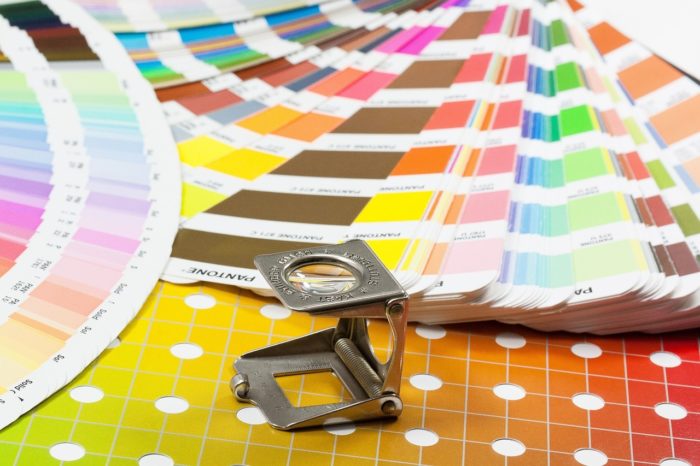Whether we’re battling deadlines, competing with charlatans, or reacting to ever-changing client demands, designers have their hands full. Read below to find out what this job is all about. Hint: It’s not as easy as it looks.
1. Graphic design is art.
In reality, graphic design is more of a science. Graphic designers solve problems in a perceptible way; they do not aim to express feelings or elicit emotions the way many artists do. Graphic design is much more than a feeling—it is a collaboration between a designer and a client or an editor to solve a specific business or communication problem. To accomplish this, designers follow visual principles and fundamentals learned in school and made habit in the workplace. For instance, there is always an underlying grid in a design. Without a grid, the layout from page to page would appear inconsistent and messy. There are branding guidelines having to do with logo and color, as well as typographic rules, that designers have to learn and follow. My design coworker and I also follow the rules we learned about creating solid and honest charts and graphs. All these guidelines mean that good designers can explain most of their choices with reason and logic.
That said, sometimes clients are not persuaded by reasoning and logic and simply want what they want. Ultimately, it is the designer’s job to meet the client’s needs, even if he or she disagrees.
2. Graphic design is just decoration.
Yes, composing something attractive is part of graphic design. However, the main goal is to display a message in an accessible way. Unsuccessful design distracts from the message. The opposite is true as well; if the message is unfocused or muddled, then even an attractive design won’t have the impact that it could.
3. Anyone who learns how to use Photoshop, Illustrator, or InDesign is a designer.
While watching tutorials online and learning how to use the Adobe programs may be instructive, the craft depends on school and work experience that teach design fundamentals. Through these experiences you quickly learn that the process begins before you launch the program. It begins with a sketch, an idea, or a vision. Otherwise, the program is going to influence your thinking. When programs start affecting your vision, you end up over-designing.
Great examples of over-design are the reissues of the original “Star Wars” movies. New technology prompted Lucas to add computer-generated (CG) material that did not mesh with the original content. The effects were less “special” than disjointed.
4. Graphic design is easy and fast.
Good design takes a lot of thought and exploration. For example, well-designed logos take hours of research, sketching, and experimenting. You have to take the time to learn about the company and figure out their essence. You also have to research similar companies’ logos to familiarize yourself with what is standard and what already exists. Only then are you prepared to construct a visual symbol or typographic solution for a particular client. That cannot be accomplished in an hour.
5. Fixing or changing a design is no big deal.
Let’s say you have just designed and laid out a long report. It’s 10 sections, it’s packed but the content fits, and it’s a perfect 60 pages. The client decides to add a sidebar into each section. That’s not an easy fix. It will require hours of rework to add these sidebars and shuffle around the entire layout. Small changes can have a large impact.
6. The simpler the design, the less it should cost.
Just because a design looks simple doesn’t mean it took less time to create than a more elaborate design. A lot of thought goes into a design, and if it’s well done, clever, and still simple, it might have required even more effort to strip out unnecessary elements.
7. Clients can always explain exactly what they want.
I wish I could mind meld with a client’s brain like Spock on Star Trek, but unfortunately I cannot. Therefore, if a client has a vision or direction for a project in their head, they have to describe it as well as possible. When we go over a project scope, what comes up visually in my head won’t be the same as what is in the client’s head. The more I learn about a client’s goals for a project, the closer I can get to creating their ideal.
Take colors, for instance. Colors have endless variations and subtleties. If I say, “imagine the color red,” the color in your head is going to be different than the color in my head. Yours might be brighter and pinker, and mine might lean more toward orange. Explicit communication between designer and client is necessary at every step.
8. Graphic design is fun.
Okay, okay, design can be enjoyable. That said, it is also stressful. Designers end up working long hours at the ends of projects because content almost always arrives later than estimated. Sometimes a lot later. And since it’s usually not an option to move final launch or printer dates, the designer’s timeline is the one that gets crunched.
Additionally, a lot of clients have stronger opinions about the visual stylings than they do about the content itself. This means designers might have to redesign or rework layouts according to the client’s feedback right up to the final deadline. And once the designer produces a laid-out draft, a proofreader usually offers corrections before the project can be finalized. As with any craft, the less time a designer has, the easier it is to make errors; so designers not only have to work quickly, but they also have to be extremely careful…and maybe try to have some fun along the way.


Leave a Reply
You must be logged in to post a comment.